新视野大学英语第三版听说教程2-Unit4-电子教案
- 格式:pdf
- 大小:43.23 KB
- 文档页数:2
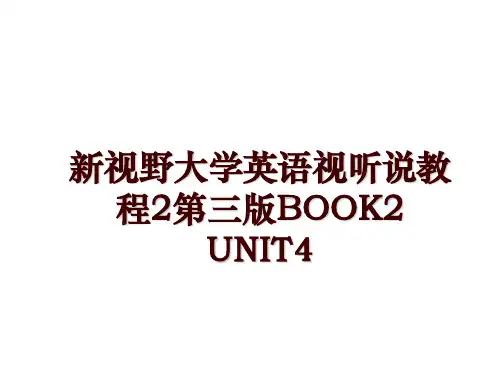

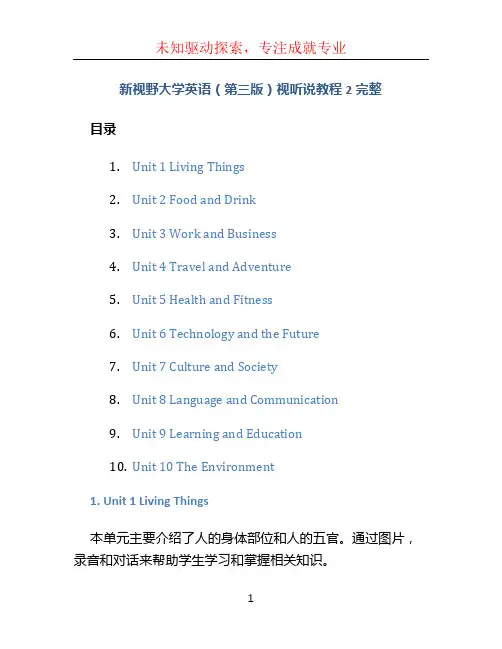
新视野大学英语(第三版)视听说教程2完整目录1.Unit 1 Living Things2.Unit 2 Food and Drink3.Unit 3 Work and Business4.Unit 4 Travel and Adventure5.Unit 5 Health and Fitness6.Unit 6 Technology and the Future7.Unit 7 Culture and Society8.Unit 8 Language and Communication9.Unit 9 Learning and Education10.Unit 10 The Environment1. Unit 1 Living Things本单元主要介绍了人的身体部位和人的五官。
通过图片,录音和对话来帮助学生学习和掌握相关知识。
1.1 Vocabulary本节重点介绍了身体部位的英文单词,并给出了对应的汉语翻译和发音示例。
单词包括head, face, eye, ear, nose, mouth, arm, hand, leg, foot等。
1.2 Sentence Patterns本节介绍了身体部位的描述方式,涵盖了be动词、形容词和名词的搭配用法。
例: - His eyes are blue. - She has long hair.1.3 Conversations本节通过一些对话情景,帮助学生了解和使用相关词汇和句型。
对话涉及到日常生活中的身体部位描述,如询问别人的身体部位、谈论自己的身体健康等。
例: - A: Where is your nose? B: My nose is in the middle of my face.1.4 Listening通过录音材料,学生可以听到一些关于身体部位的介绍和描述,同时练习听力理解和跟读。
1.5 Speaking通过与同学进行小组讨论或角色扮演的方式,学生可以运用所学内容进行口语表达。
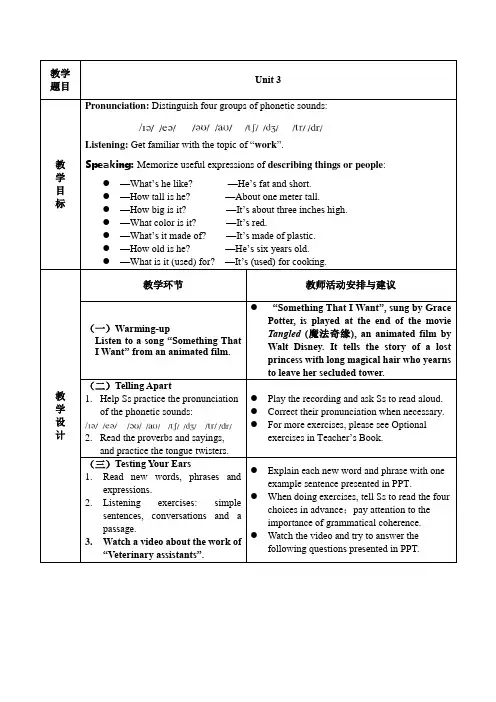
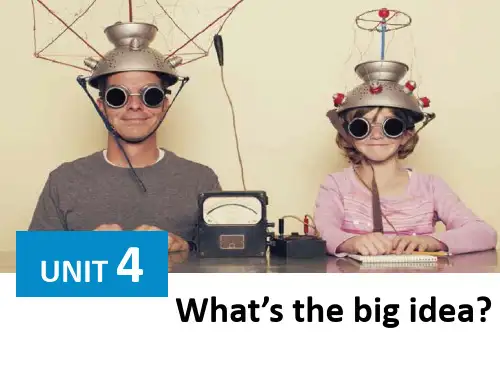
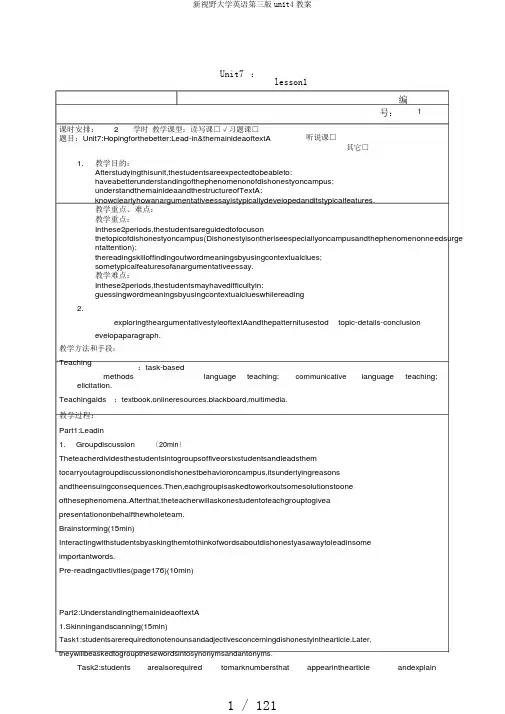
Unit7:lesson1编号:1课时安排:2学时教学课型:读写课□√习题课□题目:Unit7:Hopingforthebetter:Lead-in&themainideaoftextA听说课□其它□1.教学目的:Afterstudyingthisunit,thestudentsareexpectedtobeableto:haveabetterunderstandingofthephenomenonofdishonestyoncampus;understandthemainideaandthestructureofTextA;knowclearlyhowanargumentativeessayistypicallydevelopedanditstypicalfeatures.教学重点、难点:教学重点:Inthese2periods,thestudentsareguidedtofocusonthetopicofdishonestyoncampus(Dishonestyisontheriseespeciallyoncampusandthephenomenonneedsurge ntattention);thereadingskilloffindingoutwordmeaningsbyusingcontextualclues;sometypicalfeaturesofanargumentativeessay.教学难点:Inthese2periods,thestudentsmayhavedifficultyin:guessingwordmeaningsbyusingcontextualclueswhilereading2.exploringtheargumentativestyleoftextAandthepatternitusestodevelopaparagraph.topic-details-conclusion教学方法和手段:Teachingmethods :task-basedlanguage teaching;communicative language teaching;elicitation.Teachingaids:textbook,onlineresources,blackboard,multimedia.教学过程:Part1:Leadin1.Groupdiscussion〔20min〕Theteacherdividesthestudentsintogroupsoffiveorsixstudentsandleadsthem tocarryoutagroupdiscussionondishonestbehavioroncampus,itsunderlyingreasons andtheensuingconsequences.Then,eachgroupisaskedtoworkoutsomesolutionstoone ofthesephenomena.Afterthat,theteacherwillaskonestudentofeachgrouptogivea presentationonbehalfthewholeteam.Brainstorming(15min) Interactingwithstudentsbyaskingthemtothinkofwordsaboutdishonestyasawaytoleadinsome importantwords.Pre-readingactivities(page176)(10min)Part2:UnderstandingthemainideaoftextA1.Skinningandscanning(15min)Task1:ter, theywillbeaskedtogroupthesewordsintosynonymsandantonyms.Task2:students arealsorequired tomarknumbersthat appearinthearticle andexplainwhytheyareused.prehensionQs(page183)(15min)Part3Stylisticanalysis(15min)Concerning the writing style,t he students are guided to realize Text Ais an argumentative essay. Withregard toanargumentative essay, they shouldknowthewholetext centers onatopic andconcerning thetopic thewriter definitely hashis standpoint.Then concerningeachpartandeachparagraph,thestudentsareguidedtodiscoverthattheregenerallyisatopicsentence/statementsupportedbydetails(examplesinparticularinTextA)andaconcludingsentence/statement.板书设计:Unit7HopingforthebetterPart1.LeadinGroupdiscussionBrainstormingPre-readingactivitiesSkinningandscanningComprehensionQsPart3.Stylisticanalysis讨论、思考题、作业:PreviewthenewwordsandexpressionsoftextA;UtilizingtheinternetandgettoknowsomelifeexperiencesofAbrahamLincoln.Unit7:lesson2编号:2课时安排:2学时教学课型:读写课□√题目:Whenhonestydisappears:detailedstudyoftextA习题课□听说课□其它□教学目的:Afterstudyingthisunit,thestudentsareexpectedtobeableto:summarizethemainideaofTextA;understandthekeywords,phrases&expressions,andsentencestructures.教学重点、难点:教学重点:Inthese2periods,thestudentsareguidedtofocuson1.Keywords:eliminate;reveal;accurate;facilitate;exaggerate;imply;launch;frustrate;conscious;appropriate;expel;exemplify;extensive;awareness;etc.2.Phrases&expressions:launchacampaign;ifthis/thatisthe case;be confinedto;ripoff;descend to;turn in;copewith;nottomention;makeacomplaintaboutsth.;etc.3.Sentencestructures:Especially troubling/surprising/annoying are thereports/facts that.;Sth.,once hailedassth.,couldbecomesth.;Whetherdiscoveredornot(whetherconsciousorunconscious),sth.willdoaneffectonsth.;etc.教学难点:Inthese2periods,thestudentsmayhavedifficultyin:understandingthemainideaandstructureofTextA;; understandingandtranslatingsomecomplexsentences:教学方法和手段:Teaching methods:grammar translation teaching;communicative language teaching;elicitation.Teachingaids:textbook,onlineresources,blackboard,andmultimedia.教学过程:Part1Languagepoints(45min)Keywords:eliminatevt.1getridofsth.thatisnotwantedorneeded消除;剔除;铲除Wearetakingallmeasureswithinourpowertoeliminateviolence.我们正在采取我们力所能及的一切措施来消除暴力。
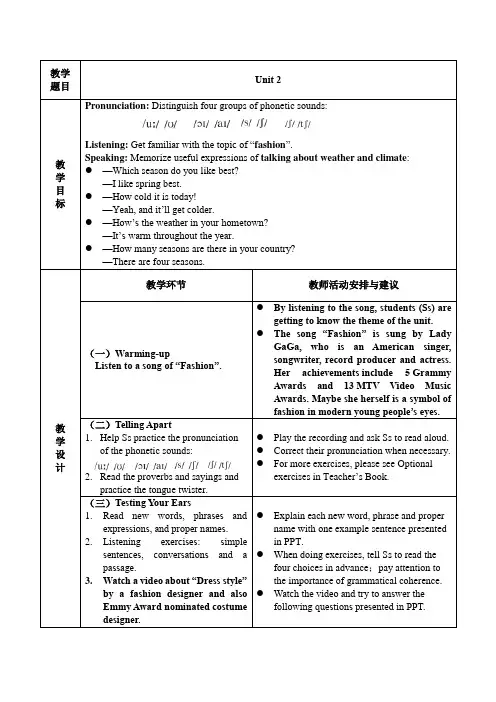
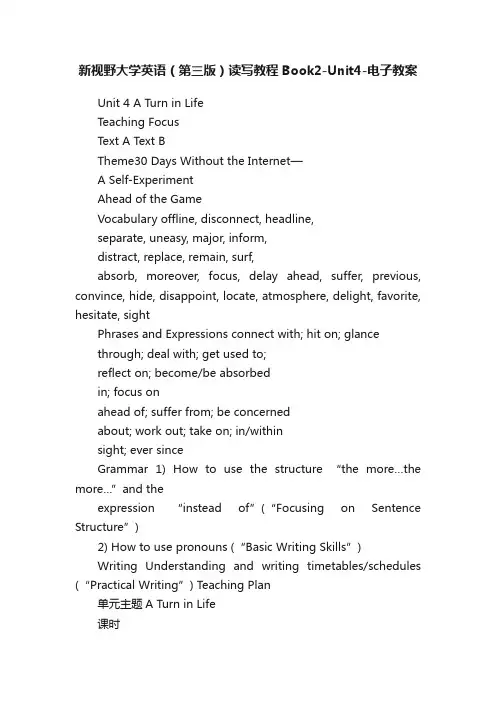
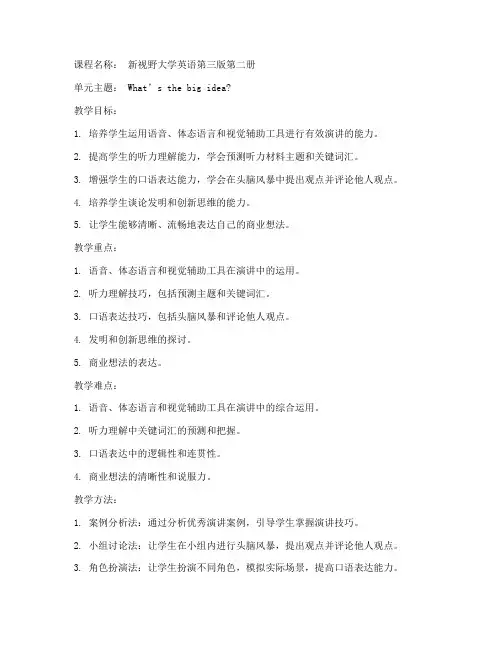
课程名称:新视野大学英语第三版第二册单元主题:What’s the big idea?教学目标:1. 培养学生运用语音、体态语言和视觉辅助工具进行有效演讲的能力。
2. 提高学生的听力理解能力,学会预测听力材料主题和关键词汇。
3. 增强学生的口语表达能力,学会在头脑风暴中提出观点并评论他人观点。
4. 培养学生谈论发明和创新思维的能力。
5. 让学生能够清晰、流畅地表达自己的商业想法。
教学重点:1. 语音、体态语言和视觉辅助工具在演讲中的运用。
2. 听力理解技巧,包括预测主题和关键词汇。
3. 口语表达技巧,包括头脑风暴和评论他人观点。
4. 发明和创新思维的探讨。
5. 商业想法的表达。
教学难点:1. 语音、体态语言和视觉辅助工具在演讲中的综合运用。
2. 听力理解中关键词汇的预测和把握。
3. 口语表达中的逻辑性和连贯性。
4. 商业想法的清晰性和说服力。
教学方法:1. 案例分析法:通过分析优秀演讲案例,引导学生掌握演讲技巧。
2. 小组讨论法:让学生在小组内进行头脑风暴,提出观点并评论他人观点。
3. 角色扮演法:让学生扮演不同角色,模拟实际场景,提高口语表达能力。
4. 任务驱动法:通过设计具体任务,引导学生运用所学知识进行实践。
教学步骤:一、导入1. 教师展示一些世界最差发明图片,引导学生讨论为什么这些发明被列入“世界最差发明”名单。
2. 引出单元主题:What’s the big idea?(什么是个大想法?)二、新课导入1. 学生阅读课文,了解单元主题和相关词汇。
2. 教师讲解重点词汇和语法结构。
3. 学生进行词汇和语法练习。
三、听力训练1. 学生听录音,预测听力材料主题和关键词汇。
2. 学生听录音,回答问题,检验听力理解能力。
3. 教师讲解听力材料,分析关键词汇和句子结构。
四、口语表达训练1. 学生进行头脑风暴,提出关于发明的创意想法。
2. 学生分组讨论,评论他人观点,并提出自己的看法。
3. 学生进行角色扮演,模拟实际场景,提高口语表达能力。
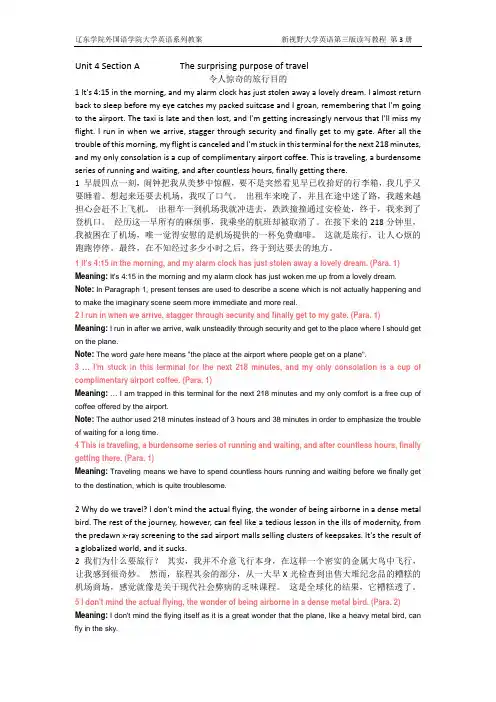
Unit 4 Section A The surprising purpose of travel令人惊奇的旅行目的1 It's 4:15 in the morning, and my alarm clock has just stolen away a lovely dream. I almost return back to sleep before my eye catches my packed suitcase and I groan, remembering that I'm going to the airport. The taxi is late and then lost, and I'm getting increasingly nervous that I'll miss my flight. I run in when we arrive, stagger through security and finally get to my gate. After all the trouble of this morning, my flight is canceled and I'm stuck in this terminal for the next 218 minutes, and my only consolation is a cup of complimentary airport coffee. This is traveling, a burdensome series of running and waiting, and after countless hours, finally getting there.1 早晨四点一刻,闹钟把我从美梦中惊醒,要不是突然看见早已收拾好的行李箱,我几乎又要睡着。
想起来还要去机场,我叹了口气。
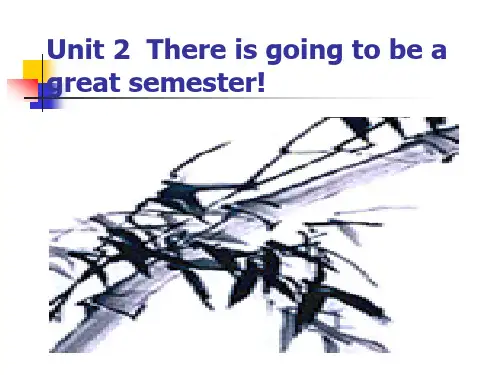
Book 2 Unit 4 College sweethearts教学重点:1.To talk about romantic love2.To learn and apply the words and phrases of the text3.Master the key language points and grammatical structures in the text教学难点:1.apply the phrases and patterns2.to listen and discuss the importance of humanities3.To critically think what makes wonder in their crisis—ridden marriage教学过程:Task 1Lead-in (Ss work in groups to discuss the following questions)1.What are the modern dating practices?Tips: casual dating, formal dating, speed dating, online dating, double dating,group dating,blind date…2. Do you think it’s a good idea to date someone at college? Why or why not? Tips: Yes, because:• it’s an ideal place to find someone who has the same aspirations.•through years of studying together, students get to know each other well。
• college has more choices than the workplace。
Unit 4Dance with loveUNDERSTANDING AND LEARNINGOverview:Unit 4 is designed to let students navigate their college romance. Text A tells a love story about two college sweethearts, while Text B presents an image of a college girl who is in love and wants to initiate the first step to date a boy. The two texts have the same theme, but the dating practices are somewhat different: One is more traditional and the other more modern. Though the rhetoric modes used in both texts are narrative, Text B, however, is also more like an exposition, with the girl’s opinion about dating being clearly stated: what kind of date is most beneficial, who should initiate , and who should pay. The teacher may want to expose students to the elaborated description of the girl’s inner struggle. To let students find out what kind of date they really want and how they can deal with it properly, the teacher may start with a class discussion, based on the pre-reading activities, and then proceed to a story-telling activity on the topic of “love just happens when you least expect it”. The activity contains two layers: from oral to writing.Section ACollege sweetheartsBackground informationCampus romance in the 1960s in the United StatesThe 1960s in the United States are often perceived today as a period of profound societal change. Attitudes to a variety of issues changed, sometimes radically, throughout the decade. The urge to “find oneself”, the activism of the 1960s, and the quest for autonomy were characterized by changes toward sexual attitudes and practices, particularly among the young. These changes to sexual attitudes and behavior during the period are often referred to as the “sexual revolution”. The sexual revolution was often seen to have been centered on the university campus, among students. While the term “revolution”implies radical and widespread change, this was not necessarily in the case. Even in the “liberal”1960s, conservative and traditional views were widely held. The love story in Text A coincides with what happened in that particular historical period of time in the United States. From the story students can see the main characters, college sweethearts back then, were actually following a more traditional pattern of dating, romantic but conservative, a clear stream on campus in the 1960s.Detailed study of the text1. I smile at my two lovely daughters and they seem so much more mature than we, theirparents, when we were college sweethearts. (Para. 1)2. Linda, who’s 21, had a boyfriend in her freshman year she thought she would marry, but they are not together anymore. Melissa, who’s 19, hasn’t had a steady boyfriend yet. My daughters wonder when they meet “The One”, their great love. (Para. 1)outset. (Para. 1)★ classic: a.(usu. before noun) admired by many people, and having a value that has continued for a long time 经典的The Coca-Cola bottle is one of the classic designs of the last century. 可口可乐瓶子上是上个世纪的经典设计之一。
Unit 4 Section A College sweethearts1 I smile at my two lovely daughters and they seem so much more mature than we, their parents, when we were college sweethearts. Linda, who's 21, had a boyfriend in her freshman year she thought she would marry, but they're not together anymore. Melissa, who's 19, hasn't had a steady boyfriend yet. My daughters wonder when they will meet "The One", their great love. They think their father and I had a classic fairy-tale romance heading for marriage from the outset. Perhaps, they're right but it didn't seem so at the time. In a way, love just happens when you least expect it. Who would have thought that Butch and I would end up getting married to each other? He became my boyfriend because of my shallow agenda: I wanted a cute boyfriend!1 我微笑着看着我那两个可爱的女儿,她们似乎比她们的父母还是大学情侣那会儿更为成熟。
教学
题目
Unit 4
教学目标Pronunciation: D istinguish four groups of phonetic sounds: Listening: Get familiar with the topic of “
recreational activities”.Speaking: M emorize useful expressions of t alking about health: —How about doing morning exercises? —All right.
—How often do you take exercise? —Every day.
—Do you have any suggestions for me to lose weight?
—You’d better change your diet.
—What do you do to keep fit?
—I go jogging every day.
教学设计
教学环节教师活动安排与建议
(一)Warming-up
Listen to a song “You belong to
me”.
By listening to the song, students (Ss) are
getting to know the theme of the unit.
The song “You belong to me” is sung by
Carla Bruni, who is an Italian-French
singer, songwriter and former model and
is married to
former Frenchpresident Nicolas Sarkozy. (二)Telling Apart
1.Help Ss practice the pronunciation
of the phonetic sounds:
2.Read the proverbs and sayings and
practice the poem.
Play the recording and ask Ss to read aloud.
Correct their pronunciation when necessary.
For more exercises, please see Optional
exercisesin Teacher’s Book.
(三)Testing Your Ears
1.Read new words, phrases and
expressions.
2.Listening exercises: simple
sentences, conversations and a
passage.
3.Watch a video about
“Televisionadvertisement”.
Explain each new word and phrasewith one
example sentence presented in PPT.
When doing exercises, tell Ss to read the
four choices in advance;pay attention to the
importance of grammatical coherence.
Watch thevideo and try to answer the
following questions presented in PPT.。